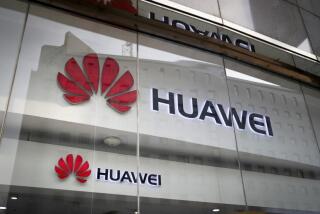Asian Computer Monitor Business Booming in Baja
Mexico’s largest electronics plant opens in Mexicali this month. The mammoth 600,000-square-foot structure is tailor-made to produce just one product: 17-inch computer monitors, about 1.8 million of them a year.
Owner Mitsubishi is the latest of more than 100 Japanese, Taiwanese and Korean manufacturers to inaugurate plants in Baja California to get closer to the U.S. market while satisfying North American Free Trade Agreement local-content guidelines and qualify for favorable duty treatment.
Mitsubishi becomes only the third company, after South Korea’s Daewoo and Samsung, to make the glass-monitor components from scratch in Mexico, a costly and technically demanding process.
Mitsubishi’s investment in the factory, which stretches the length of five football fields, is $170 million. And the company has enough land next to the factory to put up two more of equal size.
Mitsubishi’s man in Mexicali, plant manager Takashi “Tom” Ishii, has little doubt that those additional structures will someday be built, if the U.S. market holds up. Television monitors are the logical addition to the product mix.
Ishii estimates that 3 million, or about 15%, of the 20 million computer monitors sold annually in the U.S. come from Baja California. “There’s already a Silicon Valley, so we call this ‘Monitor Desert.’ ”
Mitsubishi and other Asian companies have helped bolster Baja California’s economy despite the Asian economic slowdown. In 1998, the Mexican state attracted about $1.6 billion in foreign investment, up 7% from 1997.
More than 43,000 new jobs were created, for an annual growth rate of 8.8%. That’s down from the feverish 11% pace of 1997 but still way ahead of the national rate of 5.3% last year, said state economic development secretary Juan Martinez.
But Martinez wants to correct the popular misconception that foreign companies come to Baja strictly to service the U.S. market. In fact, manufacturers come to qualify for low duties on products shipped from Mexico to Peru, Colombia, Chile and Venezuela, with which Mexico has special trade agreements. TV manufacturers such as Samsung and Sanyo ship products all over South America from Baja.
If commodity prices improve, Martinez hopes the next wave of investment in Baja California will be in mining. Already a large gold producer, the region is also rich in copper deposits at the south end of the state. Martinez said the Mexican mining company ARCO is considering a $2-billion investment in a mine and smelter.
More to Read
Inside the business of entertainment
The Wide Shot brings you news, analysis and insights on everything from streaming wars to production — and what it all means for the future.
You may occasionally receive promotional content from the Los Angeles Times.










